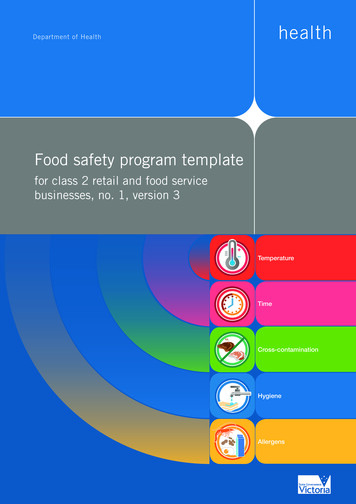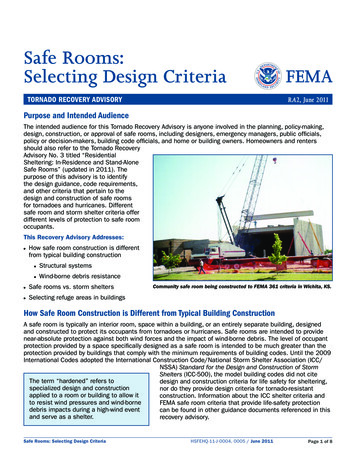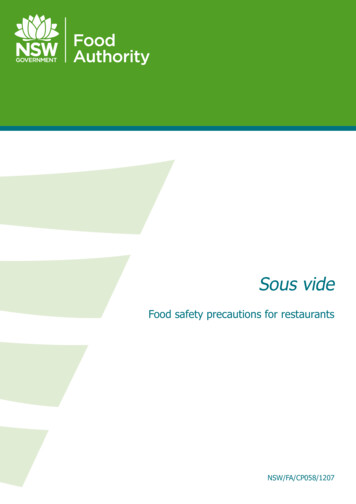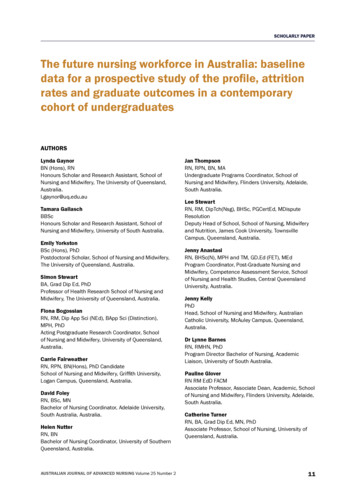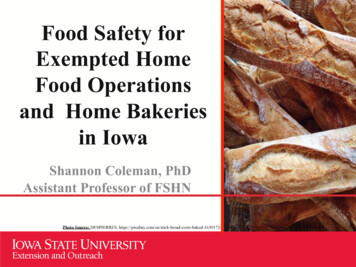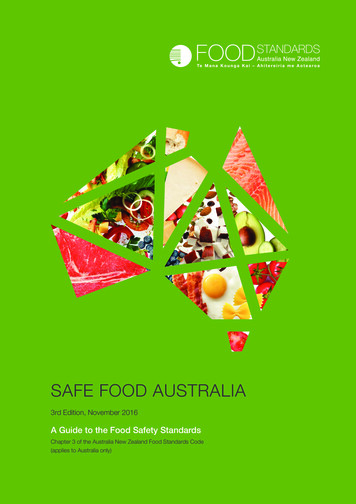
Transcription
SAFE FOOD AUSTRALIA3rd Edition, November 2016A Guide to the Food Safety StandardsChapter 3 of the Australia New Zealand Food Standards Code(applies to Australia only)
SAFE FOOD AUSTRALIAA Guide to the Food Safety StandardsChapter 3 of the Australia New Zealand Food Standards Code (Australia only)Standard 3.1.1 – Interpretation and ApplicationStandard 3.2.2 – Food Safety Practices and General RequirementsStandard 3.2.3 – Food Premises and EquipmentThird Edition, November 2016
FOOD STANDARDS AUSTRALIA NEW ZEALAND SAFE FOOD AUSTRALIAII Food Standards Australia New Zealand 2016ISBN: 978-0-642-34593-6Published November 2016Food Standards Australia New Zealand (FSANZ) supports and encourages the dissemination and exchange ofinformation. Information in this document is provided under a Creative Commons Attribution 3.0 Australia (CC BY 3.0)Licence, except for the Food Standards Australia New Zealand logo. An electronic version of this work is available onthe FSANZ website at www.foodstandards.gov.au.AttributionYou may copy, distribute, transmit and adapt the material in this publication by the CC BY 3.0 licence for commercialand non-commercial purposes; but you must attribute the work in the following manner: Food Standards Australia New Zealand.This attribution must not, in any way, suggest that FSANZ endorses you or your use of the work.For more information email information@foodstandards.gov.auFSANZ AustraliaPO Box 5423Kingston ACT 2604AustraliaPh: 61 2 6271 2222Fax: 61 2 6271 2278FSANZ New ZealandPO Box 10559The Terrace, Wellington, 6143New ZealandPh: 64 4 473 5630Fax: 64 4 473 9855A GUIDE TO THE FOOD SAFETY STANDARDS THIRD EDITION NOVEMBER 2016
FOOD STANDARDS AUSTRALIA NEW ZEALAND SAFE FOOD AUSTRALIASTATUS OF GUIDEStatus and context of the documentThis document relates to three food safety standards in Chapter 3 of the Australia New Zealand FoodStandards Code (the Code). These standards apply only in Australia. They are:3.1.1 – Interpretation and Application3.2.2 – Food Safety Practices and General Requirements3.2.3 – Food Premises and EquipmentThe information provided in this document is not legally binding.This document was prepared by Food Standards Australia New Zealand (FSANZ) to assist governmentagencies responsible for enforcing the Code in Australia.State and territory food agencies are primarily responsible for interpretation and enforcement of theCode in Australia. This is because the food standards that comprise the Code are applied in Australiaby state and territory food laws. It is the state and territory food laws that make failure to complywith Code requirements an offence. At the Commonwealth level, the Commonwealth Departmentof Agriculture and Water Resources administers the Imported Food Control Act 1992 (Cth),which applies the food standards to imported food. These agencies work together through theImplementation Subcommittee for Food Regulation (ISFR) to ensure food laws are implementedand enforced consistently.FSANZ prepared and published this document at the request of ISFR. FSANZ is not an enforcementagency and cannot provide advice or guidance on food compliance issues.This document will be reviewed and amended as necessary. Readers may contact the Food Safetyand Response Section of FSANZ if they have feedback. Email: information@foodstandards.gov.au.DisclaimerFood Standards Australia New Zealand makes no warranty or representation regardingthe completeness, accuracy, or currency of any information contained in this document orpublication or that such information will be error-free.Food Standards Australia New Zealand does not accept any legal liability or responsibility for anyharm, injury, loss, damages, or costs directly or indirectly sustained by any person as a result ofany use of, or reliance on, or interpretation of, the information contained in this publication.The information contained in this publication is not and should not be relied upon as legal advicenor be regarded as a substitute for legal advice. Any person relying on this information shouldseek independent legal advice in relation to any queries they may have regarding obligationsimposed under the standards in the Australia New Zealand Food Standards Code.AUSTRALIA NEW ZEALAND FOOD STANDARDS CODE CHAPTER 3 (AUSTRALIA ONLY)III
FOOD STANDARDS AUSTRALIA NEW ZEALAND SAFE FOOD AUSTRALIACONTENTSContentsStatus and context of the documentIIIIntroduction1Using this guide1Standard 3.1.1 Interpretation and Application31Interpretation42Meaning of safe and suitable food103General application of the Food Safety124Standards Compliance12Standard 3.2.2 Food Safety Practices and General Requirements13Division 1 — Interpretation and application141Interpretation142Application of this Standard18Division 2 — General requirements183Food handling — skills and knowledge184Notification22Division 3 — Food handling controls524Food receipt246Food storage297Food processing328Food display429Food packaging4910Food transportation5211Food disposal5412Food recall58Division 4 — Health and hygiene requirements61Subdivision 1 — Requirements for food handlers6113General requirement (on food handlers)6114Health of food handlers6215Hygiene of food handlers65Subdivision 2 — Requirements for food businesses7216Health of persons who handle food — duties of food businesses7217Hygiene of food handlers — duties of food businesses7418General duties of food businesses77Division 5 — Cleaning, sanitising and maintenance7919Cleanliness7920Cleaning and sanitising of specific equipment8021Maintenance84AUSTRALIA NEW ZEALAND FOOD STANDARDS CODE CHAPTER 3 (AUSTRALIA ONLY)V
VIFOOD STANDARDS AUSTRALIA NEW ZEALAND SAFE FOOD AUSTRALIACONTENTSDivision 6 — Miscellaneous8522Temperature measuring devices8523Single use items9024Animals and pests9225Alternative methods of compliance95Standard 3.2.3 Food Premises and EquipmentDivision 1 — Interpretation and application991001Interpretation1002Application of this Standard101Division 2 — Design and construction of food premises1023General requirements1024Water supply1085Sewage and waste water disposal1136Storage of garbage and recyclable matter1147Ventilation1168Lighting119Division 3 — Floors, walls and ceilings1209Application12010Floors12011Walls and ceilings123Division 4 — Fixtures, fittings and equipment12712General requirements12713Connections for specific fixtures, fittings and equipment13414Hand washing facilities136Division 5 — Miscellaneous14215Storage facilities14216Toilet facilities14317Food transport vehicles144Appendices147Appendix 1: Potentially hazardous foods148Appendix 2: The use of time as a control for potentially hazardous food151Appendix 3: Limits for food processes158Appendix 4: Foods requiring special care162Appendix 5: Cooling of meats after cooking172Appendix 6: Cleaning and sanitising surfaces and utensils173Appendix 7: Pest management182Appendix 8: Template examples183Appendix 9: Temporary and mobile food premises191Appendix 10: Home-based food businesses204Resources and References211A GUIDE TO THE FOOD SAFETY STANDARDS THIRD EDITION NOVEMBER 2016
FOOD STANDARDS AUSTRALIA NEW ZEALAND SAFE FOOD AUSTRALIAINTRODUCTIONIntroductionThere are five national food safety standards that apply in Australia: 3.1.1 — Interpretation and Application 3.2.1 — Food Safety Programs 3.2.2 — Food Safety Practices and General Requirements 3.2.3 — Food Premises and Equipment 3.3.1 — Food Safety Programs for Food Service to Vulnerable Persons.These standards provide a risk-based, preventative approach to providing safe and suitable food.They are based on the principle that food safety is best ensured by implementing food hygienecontrols at each stage of food handling and that additional risk management tools, such as foodsafety programs, may be required for high-risk food industry sectors.Of the five standards, Standards 3.1.1, 3.2.2 and 3.2.3 apply to all Australian food businesses andestablish fundamental requirements for minimising food safety risks. Safe Food Australia providesinformation to assist with understanding the intent of these three standards, including the food safetyoutcome(s) intended.The information in this document is primarily intended to assist enforcement authorities but itmay also be useful for food businesses. Safe Food Australia includes clarifications, examples andrecommendations based on scientific evidence and industry best practice. It is not an interpretationof the Australia New Zealand Food Standards Code (Food Standards Code) and is not a legallybinding document. The Food Standards Code is enforced in all Australian jurisdictions through stateand territory Food Acts. Food businesses needing information on complying with the food safetystandards should contact their local enforcement agency for advice.Food safety risks will vary from business to business depending on the nature of the food businessand the food handling operations undertaken. For example, factors such as inherent hazards inthe food, the potential for contamination during food handling and how the food is processedcontribute to food safety risks. Information provided in Safe Food Australia highlights factors that maycontribute to these risks at each step of the food handling process. Appendixes also provide technicaland practical information.Using this guide The text of the standards is included in bold type throughout the explanatory sections of thedocument for convenient reference. The authoritative versions of these standards are on theAustralian Government Federal Register of Legislation, accessible from the FSANZ website. The intended outcome for each clause of the standards is set out in the lightly shaded boxthat precedes the explanation for that clause. Examples aim to highlight key principles and illustrate the intent of the requirements.However, they are examples only and the options provided are not exhaustive.AUSTRALIA NEW ZEALAND FOOD STANDARDS CODE CHAPTER 3 (AUSTRALIA ONLY)1
STANDARD 3.1.1INTERPRETATION AND APPLICATION
STANDARD 3.1.1STANDARD 3.1.141FOOD STANDARDS AUSTRALIA NEW ZEALAND SAFE FOOD AUSTRALIASTANDARD 3.1.1INTERPRETATION AND APPLICATION1InterpretationStandard 3.1.1 defines terms that are used only in this standard or in both Standard 3.2.2 and3.2.3. Terms that are used in only one of the other standards are defined in the standard in whichthey are used.The definitions given in the food safety standards apply to the interpretation of these standardswhether or not the words are defined in state and territory food legislation.Some of the definitions in Standard 3.1.1 refer to the ‘Act’. The phrase ‘the Act’ was defined inStandard 1.1.1 of the previous Code to mean the Act which gives the food regulatory authority toapply the Food Standards Code. Standard 1.1.1 of the revised Code does not include a definition ofthe phrase. Instead it refers to an ‘application Act’ which is defined to mean an Act or Ordinance ofthe Commonwealth, state or territory that applies the requirements of the Code. The references inStandard 3.1.1 to ‘the Act’ should be read as a reference to an ‘application Act’. This issue will becorrected in the review of Chapter 3.Terms that are not defined in this standard or by other standards in the Code or by the food laws thatapply standards in the Code should be given their ordinary meaning. Section 1.1.1–4 of the Code alsoprovides that the Code is to be interpreted in accordance with the Acts Interpretation Act 1901 (Cth).DefinitionsUnderlined words are also defined in this standard.appropriate enforcement agency means an enforcement agency prescribed by the regulationsunder the Act for the purposes of enforcement of the Act or similar purposes.Each state and territory Food Act specifies the agency responsible for the enforcement of the Act andany regulations or standards referred to in the Act.This term is used in Standard 3.2.2 clause 4 and in relation to exemptions from requirements insubclauses 15(5), 17(2) and 17(3). It is also used in relation to exemptions from requirements inStandard 3.2.3 paragraph 10(3)(b) and subclause 14(4).authorised officer means a person authorised or appointed under the Act or other legislationfor the purposes of enforcement of the Act, or similar purposes, such as an ‘authorised officer’,‘environmental health officer’ or ‘inspector’.Each state and territory Act specifies the persons who have the authorisation to enforce the Act andassociated regulations or standards.The term is used in Standard 3.2.2 subclause 5(2), clause 12 and subclause 18(2) in relation toinformation provided by a food handler.A GUIDE TO THE FOOD SAFETY STANDARDS THIRD EDITION NOVEMBER 2016
FOOD STANDARDS AUSTRALIA NEW ZEALAND SAFE FOOD AUSTRALIASTANDARD 3.1.15The definition clarifies that ‘clean’ is a state that can be assessed physically by sight, touch and smell.‘Cleanliness’, ‘cleaned’ and ‘cleaning’ are also used in the standards, with the same intent as ‘clean’.The term is used in Standard 3.2.2 in regard to hand washing and equipment, fittings and fixtures.It is also used as part of the definition of ‘clean and sanitary condition’ in subclause 20(2). ‘Clean’is also used in Standard 3.2.3 in regard to the design and construction of food premises, garbagestorage, equipment, utensils and food storage areas of vehicles to allow effective cleaning.contaminant means any biological or chemical agent, foreign matter, or other substances thatmay compromise food safety or suitability.Biological agents include microorganisms such as bacteria, viruses and moulds. Chemical agentsinclude metals, pesticides and other chemicals that could contaminate food. Foreign matter includesphysical objects that may be in food, such as string, paperclips and glass. Other substances areincluded to ensure that all materials that may affect food safety or suitability are covered.‘Contaminant’ is used in this standard and Standard 3.2.3.contamination means the introduction or occurrence of a contaminant in food.Contamination of food has occurred if any of the contaminants referred to above are present inthe food.Food contamination can occur, for example, from: pathogenic microorganisms in raw food, unclean surfaces and utensils, or unwashed hands chemicals migrating from packaging or other contact surfaces that are not food-grade quality,or being accidentally spilt or sprayed onto food foreign objects such as pests, droppings, glass, dirt, jewellery and hair falling or otherwise beingmixed into food.It is important to note that the look, smell or taste of a food may not change as a result ofcontamination. Protecting food against contamination in storage, display, handling and transportis referred to in Standards 3.2.2 and 3.2.3.equipment means a machine, instrument, apparatus, utensil or appliance, other than a singleuse item, used or intended to be used in or in connection with food handling and includes anyequipment used or intended to be used to clean food premises or equipment.The intention is to ensure that all equipment that is used to produce food and in cleaning procedures inthe food premises is covered by the requirements. There are specific requirements for single use items.‘Equipment’ is used in clauses 8, 19, 20 and 21 of Standard 3.2.2 and clauses 3, 12 and 13 ofStandard 3.2.3.AUSTRALIA NEW ZEALAND FOOD STANDARDS CODE CHAPTER 3 (AUSTRALIA ONLY)STANDARD 3.1.1clean means clean to touch and free of extraneous visible matter and objectionable odour.1
6STANDARD 3.1.1FOOD STANDARDS AUSTRALIA NEW ZEALAND SAFE FOOD AUSTRALIASTANDARD 3.1.1food business means a business, enterprise or activity (other than primary food production)that involves:1(a) the handling of food intended for sale, or(b) the sale of food,regardless of whether the business, enterprise or activity concerned is of a commercial,charitable or community nature or whether it involves the handling or sale of food on oneoccasion only.The definition is crucial to applying the food safety standards and should be read in conjunction withthe definition of ‘handling’, ‘sell’ and ‘primary food production’. The words ‘commercial’, ‘charitable’and ‘community’ take their ordinary meanings. The intention is to cover all food businesses (other thanprimary food producers) whether or not the food is intended for sale for charity or forcommercial purposes.The definition applies regardless of the quantity of food involved, the frequency with which food ishandled or sold or the type of premises. For example, it covers the sale of food through the internet,from home and through food vending machines. It covers any food handling operations including foodstorage and transport.food handler means a person who directly engages in the handling of food, or who handlessurfaces likely to come into contact with food, for a food business.The definition covers people who prepare food and/or handle surfaces likely to come into contact withfood, for example a person cleaning eating and drinking utensils. Food handlers must comply with thehealth and hygiene requirements in Standard 3.2.2.food handling operation means any activity involving the handling of food.Examples of food handling operations are: preparing meat and vegetables for cooking, preparingsalads, serving meals and packaging food for sale.The term is used frequently in the standards to clarify that the requirement applies only in relation tothese operations. For example, food handlers are obliged to comply with hygiene requirements inclause 15 in Standard 3.2.2 only when engaging in any food handling operations.food premises means any premises including land, vehicles, parts of structures, tents, stallsand other temporary structures, boats, pontoons and any other place declared by the relevantauthority to be premises under the Food Act kept or used for the handling of food for sale,regardless of whether those premises are owned by the proprietor, including premises usedprincipally as a private dwelling, but does not mean food vending machines or vehicles usedonly to transport food.The definition covers all types of structures that are used by food businesses, including boats, shipsand planes. In addition, land used by a food business is covered. Premises permanently used bythe business (whether buildings or mobile structures such as vans) and temporary premises suchas market stalls, tents, barbeque stands, etc. are also covered.Outdoor dining areas on the street are part of the food premises serving the food. Note that‘Division 3 — Floors, walls and ceilings’ does not apply to dining areas.A GUIDE TO THE FOOD SAFETY STANDARDS THIRD EDITION NOVEMBER 2016
STANDARD 3.1.1Premises that are principally private dwellings but would be classed as food premises include premisesused for bed and breakfast, child care involving the supply of food, and domestic premises where thehandling of food for sale occurs.Note that food vending machines may be considered as food premises in state or territory legislation.For example, in Queensland vending machines are defined as mobile premises as they can bestand-alone premises moved between locations. For further information, refer to the relevantfood authority.food safety standards means the standards contained in Chapter 3 of the Australia NewZealand Food Standards Code.Currently these are Standards 3.1.1, 3.2.1, 3.2.2, 3.2.3 and 3.3.1. The term is used only in Standard3.1.1, in the definitions of ‘safe’ and ‘suitable’, and in the application and compliance provisions.handling of food includes the making, manufacturing, producing, collecting, extracting,processing, storing, transporting, delivering, preparing, treating, preserving, packing, cooking,thawing, serving or displaying of food.This is inclusive and intended to cover all the activities that take place in relation to food before itis sold. It is not restricted to the activities listed.hazard means a biological, chemical or physical agent in, or condition of, food that has thepotential to cause an adverse health effect in humans.As part of a food safety program, a business must identify potential hazards that are expected tooccur in the business’s food handling operations. These hazards may be biological, chemical orphysical agents in the food. Pathogenic microorganisms are an example of biological agents in food.Chemical agents include pesticides, toxic metals and veterinary chemical residues. Physical agents infood include foreign matter such as glass or metal fragments. A hazard may also be material intrinsicto the food but unacceptable in the final product: bones in fish products are an example.The definition also covers biological, chemical and physical conditions of food. This means that thefood is (or has the potential to be) in a state that needs to be controlled by the food safety program.An example is a food that is known to be poisonous, for example certain mushrooms, when thespecific agent causing the illness may not be able to be identified.The term is used in the definition of a food safety program in Standard 3.2.2.While allergens are not specifically covered as a hazard, food businesses should be awareof, and proactively manage, issues associated with allergens and allergen management.See subclause 2(2).pests include birds, rodents, insects and arachnids.The intention is to ensure that the requirements cover all animals that could contaminate foodeither directly or indirectly. It is not restricted to the animals listed.It is used in clause 24 of Standard 3.2.2 and clauses 3, 6, 10, 11 and 12 of Standard 3.2.3.AUSTRALIA NEW ZEALAND FOOD STANDARDS CODE CHAPTER 3 (AUSTRALIA ONLY)7STANDARD 3.1.1FOOD STANDARDS AUSTRALIA NEW ZEALAND SAFE FOOD AUSTRALIA1
8STANDARD 3.1.1FOOD STANDARDS AUSTRALIA NEW ZEALAND SAFE FOOD AUSTRALIASTANDARD 3.1.1primary food production means the growing, cultivation, picking, harvesting, collection orcatching of food, and includes the following:1(a) the transportation or delivery of food on, from or between the premises on which it wasgrown, cultivated, picked, harvested, collected or caught,(b) the packing, treating (for example, washing) or storing of food on the premises on which itwas grown, cultivated, picked, harvested, collected or caught, and(c) any other food production activity that is regulated by or under an Act prescribed by theregulations for the purposes of this definition.However, primary food production does not include:(d) any process involving the substantial transformation of food (for example, manufacturing orcanning), regardless of whether the process is carried out on the premises in which the foodwas grown, cultivated, picked, harvested, collected or caught, or(e) the sale or service of food directly to the public, or(f) any other food production activity prescribed by the regulations under the Act for thepurposes of this definition.This definition has been included to exclude primary production activities from Standards 3.2.2and 3.2.3. It does this by excluding primary food production from the definition of food business andthereby excluding it from the application and compliance provisions of this standard. Requirementsfor primary production activities are included in Chapter 4 of the Food Standards Code. PrimaryProduction and Processing Standards have been developed for seafood, meat, poultry meat, eggs,dairy products and seed sprouts.The definition is intended to ensure that if the food is subjected, by a primary food producer,to a process that substantially transforms the food, or if it is sold or served directly to the public,it is covered by these standards.States and territories have the mechanism under the definition to include and exclude specifictypes of food businesses from the application of the standards. The term is used only in clause 1of this standard.proprietor of a food business means:(a) the person carrying on the food business, or(b) if that person cannot be identified — the person in charge of the food business.The proprietor of a food business is obliged to comply with the standards except where it is statedthat a food handler is directly responsible for compliance. There may be circumstances in whichit is not possible to identify who is actually carrying on the food business, for example becausethere are communication difficulties or the business is unwilling to provide that information. In thesecircumstances the proprietor is then the person who, in the opinion of the enforcement agency, is incharge of the business.‘Proprietor’ is used in the definitions and compliance provisions in this standard and in clauses 4,17 and 18 of Standard 3.2.2.A GUIDE TO THE FOOD SAFETY STANDARDS THIRD EDITION NOVEMBER 2016
FOOD STANDARDS AUSTRALIA NEW ZEALAND SAFE FOOD AUSTRALIASTANDARD 3.1.19(a) barter, offer or attempt to sell, or(b) receive for sale, or(c) have in possession for sale, or(d) display for sale, or(e) cause or permit to be sold or offered for sale, or(f) send, forward or deliver for sale, or(g) dispose of by any method for valuable consideration, or(h) dispose of to an agent for sale on consignment, or(i) provide under a contract of service, or(j) supply food as a meal or part of a meal to an employee, in accordance with a term of anaward governing the employment of the employee or a term of the employee’s contract ofservice, for consumption by the employee at the employee’s place of work, or(k) dispose of by way of raffle, lottery or other game of chance, or(l) offer as a prize or reward, or(m) give away for the purpose of advertisement or in furtherance of trade or business, or(n) supply food under a contract (whether or not the contract is made with the consumer ofthe food), together with accommodation, service or entertainment, in consideration of aninclusive charge for the food supplied and the accommodation, service or entertainment, or(o) supply food (whether or not for consideration) in the course of providing services to patientsor inmates in public institutions, where ‘public institution’ means ‘public institution’ asdefined in the Act, if it is so defined; or(p) sell for the purpose of resale.The definition is intended to cover all circumstances in which food is provided in exchange for moneyor other benefit, as a part of a service (for example meals provided as part of accommodation) or forsome other gain to the business from providing the food. It also includes food that is provided as partof a demonstration to promote food products (e.g. taste testing) because the business expects to gainby selling the product. It does not include food that is given away and for which nothing is expected inreturn; for example food prepared in the family home for family and friends. It is not intended to includethe provision of complimentary non-alcoholic beverages or ready-to-eat foods that are not potentiallyhazardous (such as tea and packaged biscuits) provided by a business for customer comfort,for example at a hairdresser or car service premises.‘Sell’ is used within the definition of ‘food business’ in this standard.AUSTRALIA NEW ZEALAND FOOD STANDARDS CODE CHAPTER 3 (AUSTRALIA ONLY)STANDARD 3.1.1sell means:1
FOOD STANDARDS AUSTRALIA NEW ZEALAND SAFE FOOD AUSTRALIASTANDARD 3.1.1STANDARD 3.1.1102single use item means an instrument, apparatus, utensil or other thing intended bythe manufacturer to only be used once in connection with food handling, and includesdisposable gloves.There is specific discussion about single use items in clause 23 in Standard 3.2.2. It is excluded fromthe definition of ‘equipment’ in this standard.vehicles used to transport food includes shopping trolleys.Standard 3.1.1 was amended in 2005 to specifically include shopping trolleys asfood transport vehicles.2Meaning of safe and suitable foodSafe food2(1) For the purposes of the Food Safety Standards, food is not safe if it would be likely tocause physical harm to a person who might later consume it, assuming it was:(a) after that time and before being consumed by the person, properly subjected to allprocesses (if any) that are relevant to its reasonable intended use; and(b) consumed by the person according to its reasonable intended use.The intent of the definition is that safe food is food that will not cause illness or other physical harmto a person eating it, provided that the food is used as it is intended to be used. For example,raw poultry meat is likely to contain pathogenic microorganisms. However, in terms of the definition,it is considered safe at that time because it is intended to be cooked before being eaten. The presenceof pathogenic microorganisms on food that is intended to be processed to destroy thosemicroorganisms does not mean that the food is unsafe.If a person is harmed when eating a food, such as by choking on a piece of food, this does not meanin itself that the food is ‘unsafe’. If the person chokes on foreign material in the food the presence ofthat foreign material in the food may make that food ‘unsuitable’.2(2) However, food is not unsafe merely because its inherent nutritional or chemicalproperties cause, or its inherent nature causes, adverse reactions only in persons withallergies or sensitivities that are not common to the majority of persons.Some people suffer allergic reactions to foods, for example peanuts, eggs, dairy or seafood.The definition makes it clear that the presence of allergens that do not affect the generalpopulation does not make that food unsafe.However, food businesses should be aware of potential issues associated with allergens and that it ismandatory to declare the presence of certain substances in food under Standard 1.2.3 — MandatoryWarning and Advisory Statements and Declarations. The Resources and References section includeslinks to further information on allergen management.2(3) In subsection (1), processes include processes involving storage and preparation.A GUIDE TO THE FOOD SAFETY STANDARDS THIRD EDITION NOVEMBER 2016
FOOD STANDARDS AUSTRALIA
Food safety risks will vary from business to business depending on the nature of the food business and the food handling operations undertaken. For example, factors such as inherent hazards in the food, the potential for contamination during food handling and how the food is processed contribute to food safety risks.

